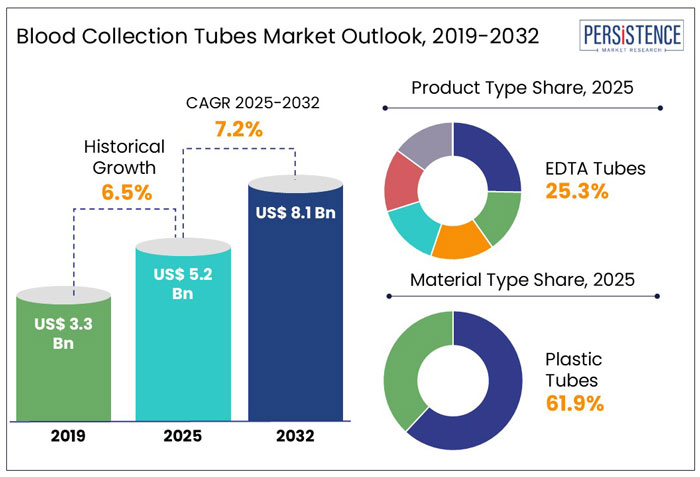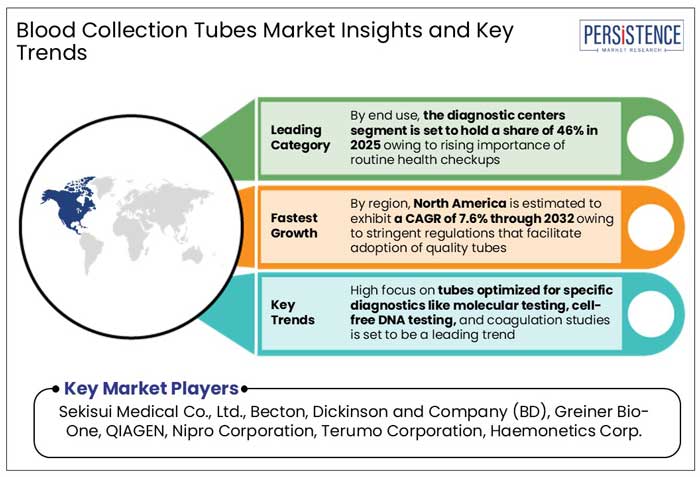Industry: Healthcare
Published Date: February-2025
Format: PPT*, PDF, EXCEL
Delivery Timelines: Contact Sales
Number of Pages: 185
Report ID: PMRREP35126
The global blood collection tubes market is estimated to reach a size of US$ 5.2 Bn in 2025. It is predicted to rise at a CAGR of 7.2% through the assessment period to attain a value of US$ 8.1 Bn by 2032.
Increasing awareness regarding early disease detection is driving the need for advanced blood collection tubes in routine diagnostic tests. Introduction of tubes designed for molecular and genetic testing are key technological innovations fostering growth.
Boold collection tubes are available in various colors that serve distinct purposes in clinical laboratory testing. Expansion in healthcare facilities and research laboratories across emerging economies are facilitating growth.

Key Industry Highlights
|
Global Market Attributes |
Key Insights |
|
Blood Collection Tubes Market Size (2025E) |
US$ 5.2 Bn |
|
Market Value Forecast (2032F) |
US$ 8.1 Bn |
|
Projected Growth (CAGR 2025 to 2032) |
7.2% |
|
Historical Market Growth (CAGR 2019 to 2024) |
6.5% |
Integration of Automation in Clinical Labs Facilitated Growth from 2019 to 2024
The global blood collection tube market growth was steady at a CAGR of 6.5% during the historical period. Rising number of health-conscious people and increased incidence of infectious diseases made diagnostic testing necessary during the time.
The period witnessed the development of micro and pediatric blood collection tubes for particular applications. Increased requirements for medical devices coupled with the implementation of stringent guidelines further escalated the demand for quality and reliable tubes.
Integration of automation in clinical labs is leading to the use of pre-labeled and barcoded tubes that are predicted to simplify sample recognition and processing. Manufacturers are specifically developing these tubes to prevent blood samples from becoming contaminated or deteriorated during manipulation and transportation. For example,
Manufacturers are Predicted to Develop Tubes for Specialized Testing through 2032
The blood collection tubes industry is predicted to grow at a CAGR of 7.2% during the assessment period. Rise in home-based and decentralized diagnostics are predicted to increase the demand for compact blood collection tubes. Tubes made from eco-friendly and sustainable materials are likely to witness increased adoption as they ensure environmental safety.
The period is likely to witness an increased demand for tubes compatible with portable testing devices. Manufacturers are focusing on designing tubes for specialized tests, including genetic testing and cell-free DNA.
Growth Drivers
Innovations in Specialized Tubes Infused with Novel Coatings and Additives to Spur Demand
As diagnostic capabilities continue to evolve, demand for advanced blood collection tubes that preserve sample integrity and enable a wide range of diagnostic tests is set to boost market growth. Demand for accurate and diverse diagnostic information has led to the introduction of specialized blood collection tubes with different additives, coatings, and properties to cater to specific testing requirements. Innovations like molecular diagnostics and personalized medicine have further extended the applications of blood collection tubes.
High Costs of Blood Collection Tubes to Result in Downfall in Price-sensitive Markets
Blood collection tubes with novel and specialized features like vacuum and gel barriers are expensive compared to ordinary ones. These high costs of innovative blood collection tubes are estimated to impede their adoption in price-sensitive markets. Manufacturers are researching less expensive but long-lasting materials, including advanced plastics and composites, to make the devices less expensive. For example,
Increasing Healthcare Expenditure Fostering Demand for Safe Blood Collection Products
Increasing prevalence rates of lifestyle diseases like diabetes and obesity, rising health care expenditure, and the rapidly emerging diagnostic industry are driving growth in the global market for blood collection tubes. An increase in demand for safe blood collection along with the growth of high-quality disposable products is likely to foster expansion. For instance,
Product Type Insights
Compatibility with Automated Analyzers Enhances Demand for EDTA Tubes in Medical Applications
EDTA (ethylenediamine tetraacetic acid) tubes are predicted to account for a share of 25.3% in 2025. This growth is largely attributed to its extensive use in diagnostic laboratories for routine blood tests.
EDTA tubes help in preserving the morphological and cellular components of blood cells. They can bind to calcium and other metal ions, preventing blood from clotting in the collection tube. Growing importance of healthcare diagnostics, including infectious diseases, chronic conditions, and genetic testing, further increases the demand for EDTA tubes. For instance,
As these tubes are compatible with automated analyzers along with being easy to use, they are in continuous demand in the medical and research fields.
Material Type Insights
Plastic Tubes to Witness Rising Adoption Owing to their Affordability and Accessibility
Based on material type, plastic tubes are anticipated to account for a share of 61.9% in 2025. This growth is attributed to its versatile properties, such as durability, cost-effectiveness, and safety.
Plastic contains polyethylene terephthalate (PET) and polypropylene, which have advantages over glass as they enhance the properties of plastic. Plastic tubes are lighter and, therefore, reduce shipping costs and are easier to handle. This feature is critical for high-volume laboratories and hospitals. They are less likely to break and handling them safely is less of an issue in a busy clinical environment. For instance,

Stringent Regulations in North America to Facilitate Adoption of Quality Blood Collection Tubes
Blood collection tubes market in North America is predicted to hold a share of 28.1% in 2025. Increasing desire for novel healthcare infrastructure, high demand for diagnostic testing, and early adoption of medical technologies are bolstering growth in the region.
The FDA and other regulatory bodies have implemented stringent regulations that ensure only the best quality and safe blood collection tubes are used in medical practices, forcing manufacturers to adhere to high standards.
Rise in chronic diseases, like diabetes, cardiovascular diseases, and cancer, requires patients to undergo frequent blood testing, thereby fostering growth. The region is projected to record a CAGR of 7.6% during the forecast period. This is owing to increasing emphasis on manufacturing sustainable tubes that are eco-friendly and contain biodegradable and recyclable materials.
Europe Sees Adoption of Specialized Tubes for Molecular Diagnostics and Point-of-care Testing
Europe blood collection market is projected to hold a share of 25.5% in 2025. The region boasts some of the most developed healthcare systems across the globe with countries like Germany, France, and the U.K. having highly efficient diagnostic networks.
Chronic diseases like diabetes, cardiovascular conditions, and cancer are increasingly prevalent in Europe. For instance,
Europe is anticipated to showcase a CAGR of 7.3% during the assessment period owing to advancements in healthcare facilities and infrastructure. Introduction of specialized tubes for molecular diagnostics, liquid biopsy, and point-of-care testing have seen rapid adoption in the region.
Asia Pacific to Account for 60% of Global Diabetic Population by 2030, Spurring Need for Blood Testing
Blood collection market in Asia Pacific is predicted to hold a share of 26.3% in 2025. The region is witnessing significant investments in healthcare infrastructure and diagnostic facilities. For example,
Growing burden of lifestyle-related diseases, including diabetes, cardiovascular diseases, and cancer, is driving demand for diagnostic tests in the region. For instance,
The region is witnessing rising adoption of innovative blood collection tubes for molecular and genetic testing. It is also seeing increasing use of point-of-care and automated blood collection systems in healthcare facilities.
Leading players in the blood collection tubes market are investing in research and development to extend their product lines. They are working on the development of novel tubes for molecular diagnostics, liquid biopsies, and genetic testing. For example,
Businesses are collaborating with diagnostic labs, hospitals, and research institutes to develop customized solutions. They are also partnering with technology companies for automated blood collection systems.
Recent Industry Developments
|
Report Attributes |
Details |
|
Historical Data/Actuals |
2019 - 2024 |
|
Forecast Period |
2025 - 2032 |
|
Market Analysis Units |
Value: US$ Bn/Mn, Volume: As applicable |
|
Geographical Coverage |
|
|
Segmental Coverage |
|
|
Competitive Analysis |
|
|
Report Highlights |
|
|
Customization and Pricing |
Available upon request |
By Product Type
By Material Type
By End Use
By Region
To know more about delivery timeline for this report Contact Sales

The market size is set to reach a value of US$ 8.1 Bn by 2032.
EDTA tubes are in high demand in the U.S.
Hospitals and clinics have a high demand for blood collection tubes owing to rising number of blood transfusions and the need for accurate blood sample procedures.
North America blood collection tubes market is set to attain a CAGR of 7.6% during 2025 to 2032.
Prominent players in the market include Sekisui Medical Co., Ltd., Becton, Dickinson and Company (BD), Greiner Bio-One, and QIAGEN.